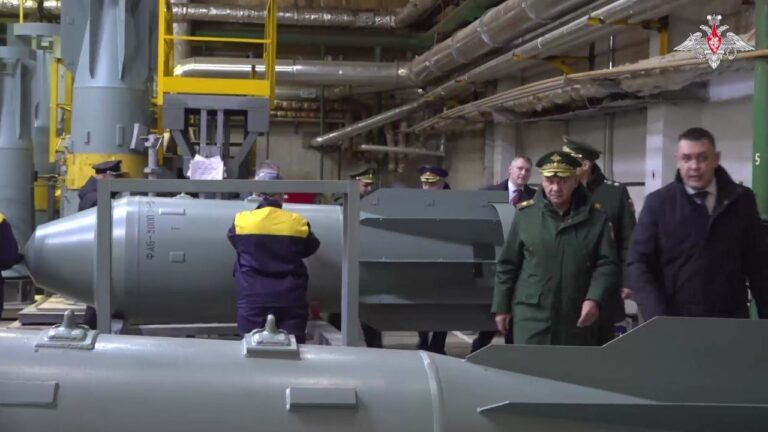The North Atlantic Treaty Organization (NATO) has announced the launch of an initiative to encourage innovators, industry and academia to develop counterglide bomb technology. The initiative comes as a result of an ongoing war in Ukraine, where these bombs are wreaking havoc.
Russia launched several catastrophic attacks on Ukraine using deadly glide bombs over the course of nearly three years of war, destroying strengthened structures, and massively in frontline Ukrainian cities caused a victim.
The catastrophe caused by these glide bombs prompted the NATO alliance from 32 members to build tenable counters against them. To that end, NATO recently announced the launch of a counter glide bomb competition to develop technologies to detect, intercept and neutralize hostile glide bombs.
The contest is a component of the 15th stage of the Innovation Challenge Technology Platform, seeking to identify creative ideas for the defense industry.
According to NATO’s Department of Transformation, the main objective of the program is to counter Russian aviation weapons including bombs, including UMPK and D-30 UMPB modules (glide bombs), which are actively adopted against Ukraine. It’s about creating a strategy.
The competition focuses on identifying threats, intercepting and physical destruction of bombs, and electronically restraining and neutralizing bombs. The contest also destroys these bombs in the air, preventing planes from reaching launch lines, protecting critical infrastructure, particularly in the cybersphere, and ensuring economic efficiency related to the object of recoil. We welcome areas such as:
Additionally, the competition encourages adopting cutting-edge technologies, including machine vision, artificial intelligence, and other creative approaches that provide superior performance and adaptability.
Why is NATO afraid to slip bombs?
Glide bombs are traditional, dropped bombs that are adapted to be fired remotely rather than directly on targets. These are simple stupid bombs that are converted into smart bombs of precision through the integration of wing kits and satellite navigation systems.
A stupid bomb is different from a smart bomb because it has no guidance system and is dropped straight down from the bomber to the target below.
The first example of a glide bomb that began World War II was the German Fritz X, invented by the Nazis. The United States subsequently facilitated the development and deployment of various gliding bombs in the war, including conflicts in Vietnam, Iraq and Afghanistan.
These bombs are considerably cheaper than cruises and ballistic missiles, and are deployed extensively by Russia and to some extent by Ukrainian forces. These improved bombs directed by the guidance system provide great destructive power.
The US has delivered joint direct armed ammunition (JDAM) kits to Ukraine for use against Russia. In fact, the Ukrainian Air Force began attacking Russian status with a 1,000 pound (or 460 kilograms) variant of the joint advanced direct ammunition-extended range (JDAM-er) bomb, as recently reported in the Eurasian era. .
Russia is revamping its old Soviet stockpile by upgrading heavy, explosive, stupid bombs with a unified gliding and correction module (UMPK). This upgrade includes foldable wings and a satellite navigation system that allows you to convert these bombs into guided ammunition and slide onto your target.

Russia widely uses 250 kilograms (FAB-250), 500 kilograms (FAB-500), and 1500 kilograms (FAB-1500) glide bombs. Fab is the Russian acronym for “high explosive aviation bomb.”
When combined with a 500-kg Fab-500 bomb, the UMPK can fly autonomously for 60-65km after being fired from high altitude by carrier aircraft (mainly SU-34) at high speeds Masu.
Some of these bombs are also equipped with UMPB D-30, with an operating range of 20-30km than the UMPK. The UMPB D-30 is frequently equipped with the FAB-250 and is converted into a guided glide bomb.
Last month, Russia used glide bombs to attack Zaporidia buildings, causing the highest civilian casualties in an attack on Ukraine in two years.
At the time, Daniel Bell, head of the Ukraine UN Human Rights Surveillance Mission (HRMMU), told Ukrainian media that “aerial environment bombs have become one of the biggest threats to civilians in cities along the frontlines. “He said. He attributed the increase in the number of civilian casualties in 2024 to these bombs.
The widespread use of glide bombs is reportedly playing a major role in Russian territorial interests in Ukraine as they are essential to be opened to advance Russian ground forces.
The Ukraine-based publication, The Kyiv Independent, has been in the process of January 2025, when Russia continues to fix and adapt destructive bombs, increasing its destructive power and scope, and has led to the creation of Ukrainian cities and villages. He reported that the problems in Ukraine are getting worse by the fact that they are making it more.
The Russian Ministry of Defense announced last March that Russia had begun mass production of three tons of FAB-3000 high-explosion aviation bombs, as previously reported in the Eurasian Times. Furthermore, the production of FAB-500 air bombs has increased, and the production of FAB-1500 has doubled.
These bombs are usually fired from standoff distances without entering Ukrainian airspace saturated by air defense systems. In March 2024, Ukrainian President Voldymir Zelensky said a whopping 3,000 glide bombs attacked targets in Ukraine.
Beyond military considerations, the affordability of guidance kits related to these gliding bombs is another important factor. For less than 2 million rubles (about 24,000 USD), these kits are significantly cheaper than one Russian Calibry cruise missile and are estimated to be worth USD 6.5 million.
Regarding Ukraine, despite the state-of-the-art air defense systems, the Ukrainian military has struggled with Russian environmental bombs. Despite concerns about their quality, Ukrainian military officials have been wreaking havoc when these gliding bombs were deployed by Russian fighters flying at very low altitudes beyond the front line. It warns that it may result.
The imminent dangers these sliding bombs pose and poor defense against these weapons forced NATO essentially to launch a counterglide bomb race. The contest highlights the urgency of NATO and building capacity, as traditional wars and wars that have returned to Europe could ripple over.


